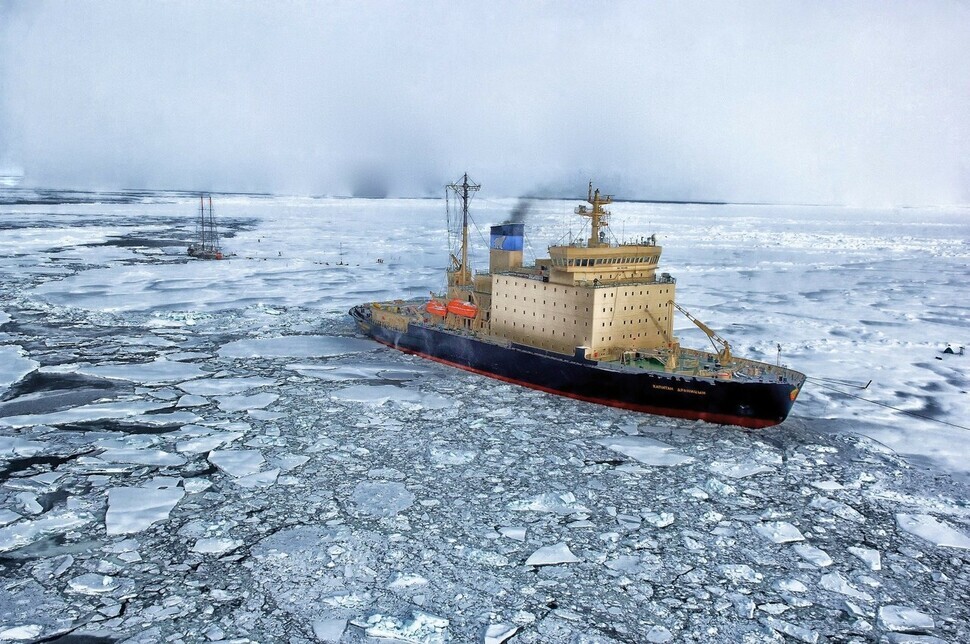hankyoreh
Links to other country sites 다른 나라 사이트 링크
Rain may soon replace snow in the Arctic, study finds

Precipitation levels in the Arctic are increasing at a rapid rate. The point at which the Arctic will switch to having more rain than snow is now predicted to be sooner than previously thought.
An international joint research team including the University of Manitoba in Canada and the University of Exeter in the UK on Monday released findings estimating that rainfall in the Arctic will increase much faster than previously thought. In particular, it noted that “the transition from a snow- to rain-dominated Arctic in the summer and autumn is projected to occur decades earlier and at a lower level of global warming.” The research team's paper was published in the scientific journal Nature Communications.
To conduct the research, the team used the sixth phase of the Coupled Model Intercomparison Project (CMIP6), which has improved simulations of the sea-ice mean state and trends over the period of satellite observations relative to the previously used CMIP 5 model.
The research team predicted that Arctic precipitation would increase more than previously predicted in all seasons if greenhouse gases were emitted at current levels. The results show that the increased precipitation is mainly due to more rainfall. At the end of the century (2100) relative to the year 2000, there is a 422% increase in CMIP6 rainfall compared to 260% in CMIP5 in winter, with similar results being observed for other seasons as well.
The study shows that most of the Arctic Ocean, Siberia and the Canadian Arctic Archipelago will become rainfall-dominated 10 to 20 years earlier than previously expected. Moreover, the Barents Sea, which has a particular impact on Korea’s winter weather, is expected to become rainfall dominant a decade earlier than previously predicted.
Although the international community is pushing to keep global warming within the limits of 1.5 degrees Celsius to 2 degrees Celsius to mitigate severe climate change, rainfall will still become dominant in Greenland and the Norwegian Sea.
The research team predicted that when the globe hits 3 degrees Celsius in warming, “most regions, except those on the Pacific side of the Arctic [will] have transitioned to a rainfall-dominated regime.”
By Lee Keun-young, senior staff writer
Please direct questions or comments to [english@hani.co.kr]

Editorial・opinion
![[Editorial] Penalties for airing allegations against Korea’s first lady endanger free press [Editorial] Penalties for airing allegations against Korea’s first lady endanger free press](https://flexible.img.hani.co.kr/flexible/normal/500/300/imgdb/original/2024/0502/1817146398095106.jpg) [Editorial] Penalties for airing allegations against Korea’s first lady endanger free press
[Editorial] Penalties for airing allegations against Korea’s first lady endanger free press![[Editorial] Yoon must halt procurement of SM-3 interceptor missiles [Editorial] Yoon must halt procurement of SM-3 interceptor missiles](https://flexible.img.hani.co.kr/flexible/normal/500/300/imgdb/child/2024/0501/17145495551605_1717145495195344.jpg) [Editorial] Yoon must halt procurement of SM-3 interceptor missiles
[Editorial] Yoon must halt procurement of SM-3 interceptor missiles- [Guest essay] Maybe Korea’s rapid population decline is an opportunity, not a crisis
- [Column] Can Yoon steer diplomacy with Russia, China back on track?
- [Column] Season 2 of special prosecutor probe may be coming to Korea soon
- [Column] Park Geun-hye déjà vu in Yoon Suk-yeol
- [Editorial] New weight of N. Korea’s nuclear threats makes dialogue all the more urgent
- [Guest essay] The real reason Korea’s new right wants to dub Rhee a founding father
- [Column] ‘Choson’: Is it time we start referring to N. Korea in its own terms?
- [Editorial] Japan’s rewriting of history with Korea has gone too far
Most viewed articles
- 1Months and months of overdue wages are pushing migrant workers in Korea into debt
- 2[Editorial] Penalties for airing allegations against Korea’s first lady endanger free press
- 3Bills for Itaewon crush inquiry, special counsel probe into Marine’s death pass National Assembly
- 4Trump asks why US would defend Korea, hints at hiking Seoul’s defense cost burden
- 560% of young Koreans see no need to have kids after marriage
- 6S. Korea discusses participation in defense development with AUKUS alliance
- 7Korean firms cut costs, work overtime amid global economic uncertainties
- 8[Reporter’s notebook] In Min’s world, she’s the artist — and NewJeans is her art
- 9[Guest essay] Maybe Korea’s rapid population decline is an opportunity, not a crisis
- 101 in 3 S. Korean security experts support nuclear armament, CSIS finds